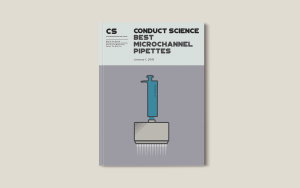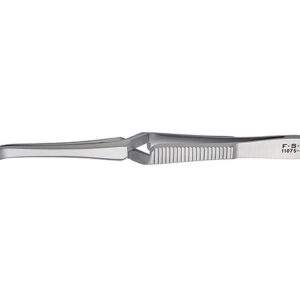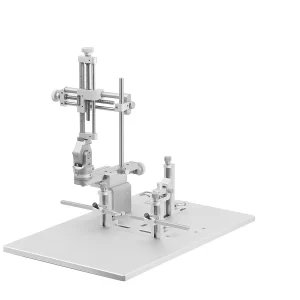
Best Microchannel Pipettes: A Comprehensive Guide
Introduction Pipetting, at first glance, would seem a fairly simple and easy task. Essentially described as glass or plastic tubes used to measure and transfer

Inverted microscopes are light microscopes whose objectives are below the stage – where examining samples are placed. It is the opposite of traditional compound microscopes, where the objectives are above the stage.
The placement enables users to examine samples from the bottom rather than the top, allowing them to observe the specimen in its container and work on it while being observed.

Inverted microscopes contain all typical components of the upright design. And the following are the key components of an inverted microscope:[1]
Modern inverted microscopes typically have two oculars with a display screen and camera connected to one ocular. A trinocular inverted microscope has an eyepiece tube, which specifically connects to a monitor and camera.
The placement of the objectives under the stage gives users better access to the specimen, thus providing these practical advantages:[1,2]
The placement of the objectives, on the other hand, is also a practical weak point in maintenance. This is particularly the case when working with oil immersion objectives, which can dribble from the lenses onto the objectives into the objective heads, unbeknownst to the user.
Along the same line, dried immersion oils, buffer, and dust can stick to the objectives, damaging the lenses and other components attached to them.[1,2] Thus, an inverted microscope requires more maintenance efforts and technical skills from users.
Inverted microscopes are especially popular for life science, clinical research, and routine diagnosis.
Inverted microscopes are go-to’s for works involving live-cell imaging and cell cultures.
Another major advantage of examining cells using inverted microscopes is the accessibility to the cells during the imaging. With necessary add-on equipment, inverted microscopes are suitable for works involving micromanipulation such as microinjection, in vitro fertilization (IVF), and cell or tissue ablation.[2]
When buying an inverted microscope, it is essential to understand the intended applications. Here are some factors to consider when buying an inverted microscope.[1]
The light source generates the light that illuminates the specimen. Hence, the information you expect from microscopic images is dependent on the wavelength and brightness of the light generated.
Most inverted microscopes possess an internal light source with adjustable brightness. Some models have an option that allows users to connect to an external light source so that a functional feature can be added later on.
Typical examples of light sources:[1]
Optical lenses in inverted microscopes are objective and ocular lenses. Together with the condenser, objectives create the real intermediate image of the specimen. The real image is reflected and amplified by ocular lenses directly to observers or on a display screen.
An essential characteristic of objectives is magnification, which is noted in the objectives by the letter “x,” which follows the magnification number. Another important characteristic is the numerical aperture (NA), designated as numbers following the magnification.
Objectives are usually removable from the nosepiece. Air objectives produce lower magnification, typically 5x, 10x, 20x, and 40x.
Higher magnifications (such as 60x and 100x) are achieved by oil immersion objectives, requiring immersion oil for imaging. The required oil must have the same refractive index (RI) value as oil immersion objectives.
Similar to objectives, magnification is the most important characteristic of ocular lenses, but they are typically available only in one magnification, as indicated on the lenses.
Together with the diaphragm, the condenser filters and focuses the light from the source. For the most optimal image resolution, the numerical aperture value of the condenser should be equal to those of the objectives. Otherwise, the condenser’s NA value should be greater than the objective’s value to create an evenly illuminated field.
In addition to magnification and resolution, microscopic techniques are crucial in obtaining high-quality pictures from an inverted microscope.
Brightfield microscopy is the conventional, default microscopic technique. Inverted microscopes with a typical light source, objectives, and ocular lenses can perform brightfield microscopy.
In contrast to brightfield microscopy, the darkfield technique creates a black instead of white background. It is suitable for observing the external structure of colored samples that are somewhat transparent. This is achieved by a darkfield condenser, which partially blocks the light source, illuminating the specimen from the side.
In phase-contrast microscopy, the specimen is lit from the sides to enhance the contrast of the sample. The so-called phase objectives, plate, and condenser annular create phase-contrast images added to the objectives and condenser.
Phase-contrast microscopy is a popular technique for the live imaging of cell cultures in their natural condition, including the internal structures of the cells. For example, the trinocular inverted microscope, and trinocular phase-contrast digital microscope include phase-contrast objectives and a condenser with the phase-contrast device.
Lastly, inverted microscopes can also have additional features, such as an eyepiece tube linked to a camera or monitor, allowing microscopic pictures to be taken. Another example is a color filter placed between the diaphragm and condenser to adjust the light’s color.
Inverted microscopes are compound light microscopes that look into a specimen from below. Users can acquire microscopic images of cell cultures directly from the culture vessels in real-time.
Unlike the traditional upright design, users can access the top of the specimen while being examined to perform micromanipulation techniques.
Need to purchase an inverted microscope for your lab? Check out our digital inverted microscope!

Introduction Pipetting, at first glance, would seem a fairly simple and easy task. Essentially described as glass or plastic tubes used to measure and transfer

Resource Identification Initiative: A Key to Scientific Success and Analytics The key to success can be found in the essential principles of the Resource Identification

INTRODUCTION AND BRIEF HISTORY One of the most important pieces of equipment in the laboratory is the centrifuge, which facilitates the separation of samples of

INTRODUCTION AND BRIEF HISTORY One of the most important pieces of equipment in the laboratory is the centrifuge, which facilitates the separation of samples of






DISCLAIMER: ConductScience and affiliate products are NOT designed for human consumption, testing, or clinical utilization. They are designed for pre-clinical utilization only. Customers purchasing apparatus for the purposes of scientific research or veterinary care affirm adherence to applicable regulatory bodies for the country in which their research or care is conducted.